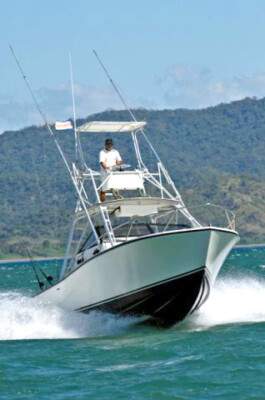The southern Nicoya Peninsula is one of Costa Rica’s most secluded vacation destination gems. From the hilly interior the mountains sweep down to the Pacific Ocean, creating some of the most beautiful and solitary beaches of Costa Rica. And research by The Blue Zones Quest in Nicoya in 2007 reveals how residents live long and happy lives here.
Because of poor roads, this beach area tropical paradise has long been off the beaten track for vacation travelers in Costa Rica. But roads and transportation are improving, and tourism is now an important part of the economy. Recently a new car ferry has been purchased to speed transportation between Puntarenas to Cobana and on to Tambor and other southern beach areas of the Nicoya Peninsula.

Thankfully, hotels and businesses have still remained small and mostly privately owned, helping to preserve the relaxed and unhurried atmosphere of the Nicoya peninsula. Travel here can be slow so resign yourself to a leisurely pace. When you arrive at your beach vacation destination you’ll be glad you came.
As it has always been easier and faster to travel to the southern Nicoya Peninsula by boat from Puntarenas, the region belongs to the province of Puntarenas rather than Guanacaste. Roads connecting to the northern province Guanacaste are still few and in poor condition.
While Guanacaste Costa Rica is known for its dry climate, the southern part of the Nicoya Peninsula receives more rain annually, making it a transitional zone between dry forest climate and tropical rain forest. The wildlife in Southern Nicoya peninsula is common to both ecosystems and many animals are seasonal commuters.
The Nicoya Peninsula experiences two extremely different seasons: the dry season begins at the end of November and until May the sun drenches the land, making the beaches popular with Ticos and foreign tourists alike. Many trees lose their leaves and cars driving on the rutted dirt roads stir up clouds of dust, covering the roadside foliage and houses with a dull, brown layer.
The first rainfalls to relieve the dry season occur in May, initiating the “little summer”, a period of rain and showers. Rainfall increases during the following months to becoming very heavy in September to November, when the peninsula turns into a dripping lush rainforest. Temperatures during the rainy season, called winter here, may sometimes drop to 17 º C, while in summer, the dry season, the thermometer may climb up to 38 º C.
It takes a bit longer to travel to the Southern Nicoya Peninsula of Costa Rica than to many other parts of Costa Rica, but it’s worth it; you will certainly have some beautiful vacations on the beach and in the mountains.
The Gulf of Nicoya

The Gulf of Nicoya which separates the Nicoya Peninsula from the mainland of Costa Rica is a stunning marine and coastal landscape of wetlands, jagged rocky islands and cliffs, extensive mangrove habitat, and high biodiversity.
A geological fault once caused the land to submerge, leaving exposed only the tops of what were formerly low hills. These are the numerous islands which today dot the Gulf of Nicoya in Costa Rica.
At its upper end towards the north, the Gulf of Nicoya is shallow and muddy. The Tempisque River washes much soil and organic material into the estuary, and mangrove swamps thrive on the shores. In Costa Rica mangroves are protected because they play an important role for aquatic life. In their foliage birds nest and the mud at their roots shelters mussels, crabs and shrimps.

The water in the upper Nicoya Gulf is rich in nutrients, allowing algae to flourish which feeds fish and molluscs. Most of the area’s inhabitants depend on food from the sea. From July to August however, nobody is allowed to fish, as this is the breeding time for maritime life.
The lower Gulf of Nicoya is much different from the upper part. There are few mangroves and the area is even less populated. Densely forested hills and promontories touch the sea, closing off secret bays. It is a fun adventure to rent a boat and explore these quiet Costa Rican coastal waters. The water here is saltier, clearer and much deeper: between 30 and 180 meters. There are many fish in the lower Gulf but by far fewer shrimp and shellfish.
Currently, only few of Costa Rica’s tourists visit this region – an advantage for those who love nature instead of crowds.
Playa Tambor
The Tambor beach area of Nicoya Peninsula provides numerous activities and diversions including a Casino at the Barcelo Playa Tambor Hotel, golf, world class sport fishing charters in the pacific ocean, scuba diving, mountain biking and horseback riding to name just a few. Tambor has several churches and a health clinic and 40 km away a major hospital in Puntarenas.
Playa Tambor is set in a valley of a large peaceful bay, Bahia Belena or whale bay. The beaches are soft sand and the waters shallow, perfect for swimming and enjoying the sensual Pacific ocean waves. Playa Tambor is surrounded by forested hills, part of a national Costa Rican biological corridor. The Curu Wildlife Reserve provides access to this wonderland of plants and animals, offering five ecological habitats to explore.
Costa Rica Phone and Internet Services
Costa Rica has a modern telephone and internet infrastructure, though the costs and speed are not comparable to north American counterparts. Most homes have land lines, and those that don’t have cel phone service. Fiber optic cable is being installed in many parts of the country and the promise of real high speed internet service looms on the horizon.
Los Delfines Golf and Country Club is in an unbelievably beautiful setting of tropical scenery and ocean vistas. The course is nine holes with another nine in development. Standard green fees are $20 for one round of nine holes. Unlimited golf play is available for $30 per day.
On the southern tip of Nicoya Peninsula is the Cabo Blanco Nature Reserve, one of the most beautiful parks in all of Costa Rica, and the first protected habitat in Costo Rica. Cabo Blanco features more than 3000 acres of primary forest and many miles of beautiful coastline home to countless animal and plant species, such as white face monkeys, howlers, squirrels, wild cats, ocelots and more.
For a real adventure visit Costa Rica’s Barra Honda National Park where intricate limestone caverns are still explored and mapped by spelunkers and scientists.
Ostional Wildlife Reserve was created in 1984 to protect the nesting beach of the Olive Ridley sea turtles. Near the third quarter of the moon, thousands of these magnificent animals come to burry their eggs in the black volcanic sands.
Come visit the Nicoya Peninsula for a Costa Rican vacation adventure of a lifetime. Stop by Beach Area Properties Real Estate and say Pura Vida and let us show you some outstanding Costa Rica Real Estate investment opportunities.
